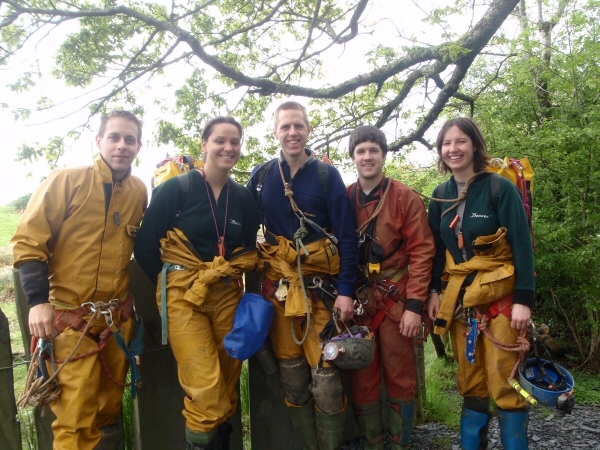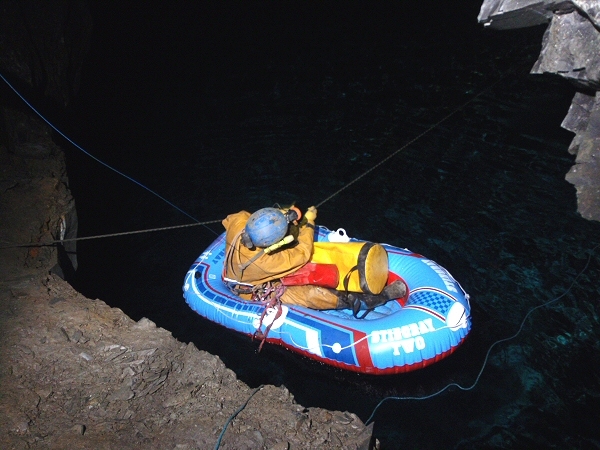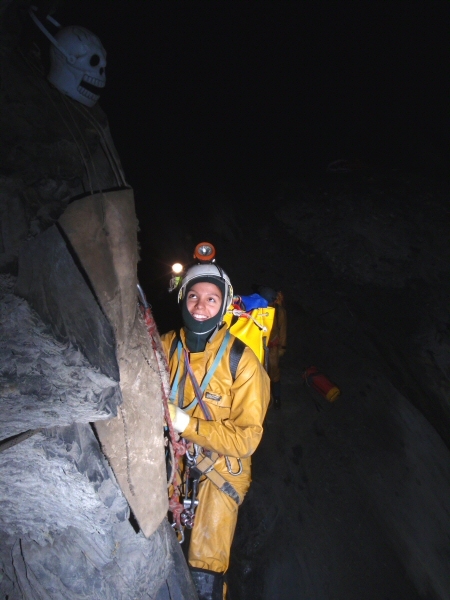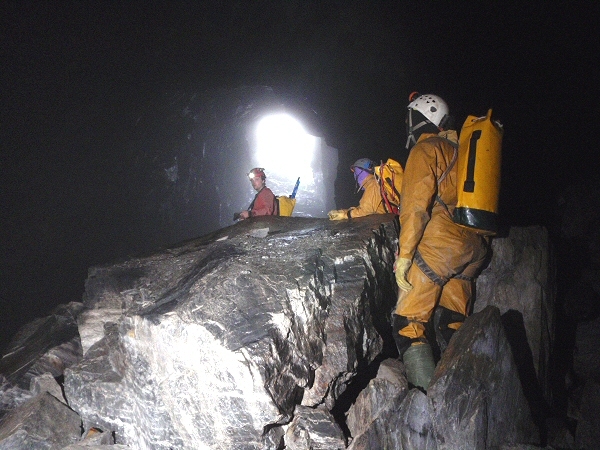I would defiantly say that Crosoer Rhosydd mine is the most fun you can have underground! It's like the ultimate cavers adventure playground! Crosoer Rhosydd has some of the most fun (and at times terrifying) wire traverses I've ever seen.
After a long walk up the hill overlooking spectacular landscape, we were greeted with the prominent winding house and steep track-way leading down into the bottom of the valley. The large flat plateau around the winding house is littered with old mining history - twisted wire and buildings in various states of decay. At one end of a row of these structures is the remains of a water wheel, and just behind is the entrance to Crosoer mine. The actual entrance has long since been closed off behind a steel door and tons of rubble, however the way in is through a grill on the left.
The classic adit entrance is fairly un-inspiring until, after a short walk, we entered a large area with several ways on and a very deep hole, filled with water in the middle of the floor. To the right leads to probably one of the eeriest places I ever been in; a huge excavated hall towering up for at lease thirty meters, with slanted rock lined with blast holes. Below, the floor descends downwards and is filled up to the floor of the entrance with water - deathly still and totally silent. It's possible to drop a rock into the water and watch as it drops for some distance until disappears out of site in the clear blue water.
Leaving the flooded hall, the way on was up a slope following a large pipe, passing a window overlooking the first hall from a higher level. The slope ends at the head of pitch overlooking another huge hall, again totally silent. Matt, Ade, Laura and Tash went down the fixed rope one by one while I set up my camera to catch the descent. I followed last and dropped into one of the biggest caverns I've ever been in, stroon with huge, bus sized boulders. We had been told that rocks fall out of the roof regularly and its best not to make much noise (not sure how true that is!) Not wishing to tempt fate, we preceded in silence (unusual for cavers) through the bouders to another, longer descent was made by some rope of dubious vintage running via some home made rope protectors over a ledge and down to a smaller chamber.
Next came the first of many wire zip lines. Ade had purchased a steel pulley especially for the occasion (defiantly a must as the wire will shred the cheaper alloy ones). After some debate about how best to cross the wire over the deep water we decided to just clip in and jump! Thankfully we'd remembered some cord to pull the pulley back after each trip over. After taking some photos, I clipped on and leaped off the ledge. The wire is quite steep and I didn't expect how fast I'd be moving. The wall on the other side appeared out of the darkness so I just stuck out my legs, closed my eyes and braced for impact. The resulting ungraceful thud shuck my bones but wasn't too bad - just make sure you're not going head first!
After everyone made it across, it was time to blow up our £5.99 inflatable dingy. It turned out that we didn't really need it as there were several already there, all be it half were flat or on the bottom. As Tash had here head inside our dingy puffing away as hard as possible, we heard voices from behind - another group of cavers were catching us up. We picked up the pace and made the relatively short voyage over the lake and the dingy was deflated - I think bringing ores (much to the entertainment of the other group) was rather over the top.
Onwards through more large mine passage to the next zip wire and one of several crossings over flooded passages below. As we crossed each of the similar obstacles, the remains of the bridges were getting increasingly less and less until the last one - "the bridge of death" - where only a bendy old iron rail was there for the foothold. To add to this, the zip wire was re-belayed half way which made for some interesting discussion on how to get the pulley back for the next person. In the end we managed to cobble together and improvised system using some steel krabs - a bit crude but it got us all over (not helped by the comments from the group behind us, waiting to cross).
Out came the dingy again. This time we had to abseil into it! Ade took the first journey and I went next. The way on is to cross a large stretch of flooded passage – easily twenty meters wide and thirty meters long. Once again, ores weren't required as an ingenious hauling pulley system had been erected to pull our rather unstable vessel along and then return it for the next passenger. This area we named the boat graveyard as it was littered with all manor of rather un-seaworthy dingys - some even could be seen on the bottom or caught on rocks. We utilised one of the other dingys for Matt, Laura and Tash to make the crossing quicker.
After debarking and making the short climb up to the continuation of the level, it was easy going. We went through the connection with Rhosydd mine and passed some rather impressive workings to the climb up to the exit.
The exit was far bigger than I expected a huge hole at the head of a steep boulder slope with sunlight streaming in quite spectacular. Getting out of the mine was easy, however getting out of the shake hole was rather more of a challenge! After Laura made a rather dangerous attempt at climbing up a wet slope, we all made it up to the moor top to find we were in thick fog. Time for the GPS we thought, and a good thing we had it too. We found our way back to Crosoer without too much difficulty (apart from Laura who fell up to her middle in a bog) and made our way down, below the fog to the village.
An excellent and very satisfying through trip, making a nice change from our usual dales caving. I would defiantly recommend visiting this mine soon as it probably won't be passable for much longer due to the sate of decay of some of the features.
More articles
Exploration of the Excalibur MEGA extensions
By Matt Ewles | 14 Aug 2025
Excalibur streamway extended!
By Matt Ewles | 7 Aug 2025
Dan-yr-Ogof Far North
By Matt Ewles | 27 May 2025
Brown Hill Pot
By Matt Ewles | 22 Apr 2024
Sunny Bank Holiday in Wales
By Matt Ewles | 5 Jun 2023
Avoiding the January Blues in Rift Pot
By Tash Durham | 16 Jan 2023
North Wales Slate Mines 2022
By Matt Ewles | 5 Dec 2022
Long Churn beginners trip. 10th October 2022
By Conor Morrison | 11 Oct 2022
Covid Extensions surveying complete!
By Matt Ewles | 1 Sep 2022
Mountaineering in North Wales
By Matt Ewles | 1 Sep 2022




